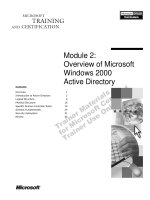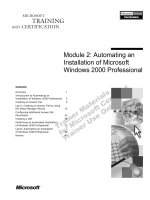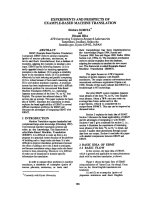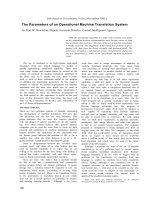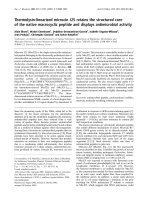Make of use Windows mac
Bạn đang xem bản rút gọn của tài liệu. Xem và tải ngay bản đầy đủ của tài liệu tại đây (1.62 MB, 28 trang )
Computing Harmony: How To Seamlessly
Blend Windows and OS X
By Matt Smith,
Edited by Justin Pot
Cover Background Photo By James Thew via Shutterstock
This manual is the intellectual property of MakeUseOf. It must only be published in its original form.
Using parts or republishing altered parts of this guide is prohibited without permission from
MakeUseOf.com
Think you’ve got what it takes to write a manual for MakeUseOf.com? We’re always willing to hear
a pitch! Send your ideas to ; you might earn up to $400.
Table of Contents
Introduction
File and Software Compatibility
Sync and Cloud Services Compatibility
Smartphone Compatibility
Network Compatibility
Conclusion
MakeUseOf
Introduction
PCs and Macs – Living Together More Than Ever
It’s no secret that Apple has experienced success over the last decade, and although much of that has
come from the iPhone and iPad, the Mac division is going gangbusters as well. The release of Lion
has, according to some sources, allowed OS X to reach double-digit market share numbers. Others
disagree, stating that market share is lower – but don’t disagree that the numbers have been
consistently rising.
Whatever the case, the robust sales of MacBooks and iMacs means that a number of people are
choosing to use a Mac as at least one of their computers. What it doesn’t mean, however, is that these
households are being taken over by Apple entirely. According to a 2009 report by NPD, 85% of Mac
owners also have a PC at home. And those who don’t almost certainly have a PC at work.
Unfortunately, PCs and Macs don’t always play nicely out of the box, which can be frustrating. That
doesn’t have to be the case, however. If you know the right tricks – most of which are simple and free
– you can easily manage both under the same roof.
The Switch to Intel – Improving Compatibility Ever Since
At the beginning of the decade, compatibility between PCs and Macs was a real mess. Part of the
reason for this, besides the use of different operating systems, was the use of different processors.
PCs have long used x86 processors from Intel and AMD, but Apple continued to hold on to the aging
PowerPC architecture.
That changed in 2005, however, and compatibility between the two operating systems has improved
ever since. It has become much easier to run either operating system on hardware of your choice.
Microsoft released an OS X version of Office, finally giving Mac owners a no-compromise way to
open those pesky .docx files. And more developers than ever before offer software for both operating
systems.
If current trends continue, this improvement in compatibility won’t stop. While Apple products grow
in popularity, Microsoft remains absolutely entrenched in the enterprise space, and in the homes of
most consumers. In addition to this, increasing reliance on cloud services for storage and app data
should enhance compatibility for all devices.
OS Versions Covered
Before we dive into the guide, it’s necessary to do some housekeeping and talk about the versions of
each operating system we will be discussing.
All of the examples you find here are applicable to Windows 7 and Mac OS X Lion. Many of the
tricks will also work in Windows Vista and Mac OS X Snow Leopard, and some of them will work
in even older versions of each operating system.
We can’t practically provide information about every version of Windows and every version of OS
X, as both operating systems have undergone significant changes over time. If you have an older
version, you will still find this guide helpful, but you may have to look up additional sources of
information to figure out certain topics. In addition, some recommended software solutions may not
work on your computer.
File and Software Compatibility
Windows PCs and Macs now use very similar hardware. They can run on the same processors, store
data on the same hard drives, and use some of the same video cards. Yet the way they store data
remains different.
Windows currently uses a file system called New Technology File System, more commonly known by
the acronym NTFS. It replaced FAT as the file system used by Windows as of Windows 2000 and
has stuck around ever since, though some revisions have been introduced over time. Before that,
NTFS was used by Windows NT.
Apple, on the other hand, uses HFS Plus. Introduced as part of Mac OS 8.1, it’s been part of Apple’s
operating systems ever since and there so far have been no indications that will change. This file
system can also be used by the iPod.
Unfortunately, these file systems are not compatible. As of Mac OS X 10.3, it is possible for Apple
computers to read files from an NTFS formatted drive, but not write. Snow Leopard includes
unofficial NTFS read/write support that can be enabled by the user through the Terminal, but it’s been
known to cause instability.
If you’re on a PC and trying to work with a drive formatted on a Mac, the situation is even worse.
Windows cannot read or write files stored on a drive formatted by HFS Plus. Mac computers using
Boot Camp are an exception, thanks to a special driver installed by Apple as part of Boot Camp
setup, but even then it’s only possible to read from HFS Plus.
Creating a Drive That is PC/Mac Compatible
So, if NTFS and HFS Plus don’t play nice, what’s the solution?
FAT32. This old file system, introduced in 1980 by Microsoft, is read/write compatible with both
Windows and OS X. If you need to read and write files to a drive from computers with either
operating system, formatting that drive in FAT32 will solve your woes.
However, Windows 7 will not let you format a drive with the FAT32 file system if that drive (or the
partition on that drive you’re trying to format) exceeds 32GB. To get around this, you can use a free
utility called Fat32Formatter. Apple doesn’t impose this limit, so you can format a drive of any size
using Disk Utility.
Now, you might be wondering – why wouldn’t I want to format all of my drives with FAT32? Well,
the reason is simple – both Windows 7 and Mac OS X will not install to a drive formatted with
FAT32. Critical functions of both operating systems rely on features that are a part of their respective
file systems, so while both can read and write to FAT32, neither will install to a FAT32 disk or
partition.
Another serious issue is FAT32’s file size limitation of 4GB or smaller, which is a consequence of
the system’s design. If you work with very large files, this will be a major roadblock.
Also, FAT32 is just slow.
Software Solutions to File System Problems
For most people, formatting an external drive that is to be shared by a PC and a Mac is a simple
solution. The shared drive will likely only store media files and backups, and no excessively large
files, so the limitations of FAT32 are not an issue.
But what if you’re not most people? What if you need to be able to directly read/write from NTFS to
HFS Plus or vice versa?
Mac users will want to check out Tuxera NTFS for Mac. The software is commercial, and while you
can enjoy a 15 day trial to see if you like how it works, you’ll have to pay 25 euros for the software
after that. Alternatively, you can purchase NTFS for Mac OS X from Paragon Software, which at
$19.95 has a clear price advantage.
Paragon Software also offers HFS+ for Windows, which again costs $19.95 and offers read/ write
support for the HFS+ format to Windows 7 as well as Vista and XP. Another option for Windows
users is Mediafour’s MacDrive 9, which is priced at $49.99. A five-day trial is offered.
Software Is Still Isolated
Although it does require a little effort, moving files between external drives, Macs and PCs is a
problem that can be solved. It’s even easier if you rely on networking, as we will discuss in chapter 5
of this guide.
Software, however, is still a quagmire. With few exceptions, all currently available software is
compatible with only one operating system or the other. This is true even if the software is available
for both platforms. In other words, most software demands that you purchase individual Mac and PC
versions, even if the functionality of the software is identical on both platforms.
For example: if you purchase Microsoft Office 2010 for Windows you cannot install it in OS X.
You’ll need to purchase Office 2011 for Mac as well.
There are some exceptions. One of the most notable is Steam, the gaming platform from Valve. Some
games available are compatible with both Mac and PC, and when you buy such a title, you usually
receive both versions.
Are Boot Camp And Virtualization A Solution To Software Issues?
Since 2006, Apple has offered a piece of software on the Mac called Boot Camp. It’s a multi-boot
utility that includes support for installing Windows on a Mac computer by partitioning off part of the
hard drive and formatting it in the required NTFS file format. Though I could go into the installation
process, it’d be rather pointless, as Apple already offers extensive installation guides for Mac
running OS X Lion and Snow Leopard.
Boot Camp isn’t the only option for installing Windows on a Mac. Virtualization, which is the
process of emulating separate computer hardware using a single computer, can actually be more
effective than Boot Camp because it’s possible to enter Windows without rebooting. Both VMware
Fusion and Parallels are capable of this, but you will have to hand over cash for both.
It’s also possible to run Mac OS X on a Windows computer using VMware, but the implementation is
far more complex, and only certain PCs will be compatible. For instructions, check out the OSx86
Project’s wiki. Alternatively, you can try to build a Hackintosh.
No matter what you try, however, dual-booting and virtualization are not great solutions to software
issues for households that own both PCs and Macs. They are primarily geared towards people who
own only a PC or a Mac, but want to be able to run both Windows and OS X. Using virtualization
and/or dual-booting as a means of circumventing software compatibility can be complex, time-
consuming and expensive (if you do everything legally, as you’ll need to buy a copy of Windows for
your Mac, and a copy of OS X for your Windows machine).
Sync and Cloud Services Compatibility
If you’re looking to routinely transfer files between a Windows PC and a Mac, formatting a drive in
FAT32 can do the trick. However, as you may have noticed in the previous chapter, there’s a lot of
catches and the end result could be a bit awkward to use and, if you don’t have a nice external drive
already, could cost you a fair chunk of change.
Services and tools that can sync your files or provide cloud storage are one answer. They work well
because the place you are storing your files to be used on both your Windows PC and your Mac is
format neutral. You can transfer files between a PC and Mac all day long without ever knows what
the acronyms NTFS or HPS+ stand for.
What’s the catch? In most cases, it’s capacity. Compared to hard drives, the storage capacity on a
cloud storage service is usually small. The price of using these services can also become expensive
over time, because you often have to pay a monthly service fee.
But these disadvantages don’t apply to all sync and cloud services generally. Let’s have a look at
some that work the best, and the price (if any) you must pay for them.
The Best Ways To Sync Windows And OS X
Windows Live Mesh 2011 For years, Microsoft has offered a sync service that is completely free.
It was called Windows Live Sync, and has now been renamed Windows Live Mesh 2011.
It’s an often overlooked service that Ars Technica called “frustratingly bad.” Some of the points of its
detractors are well taken. Of all the services here, it is the hardest to use, because the interface is a
strange combination of software installed on the PC you would like to sync and a web-based interface
on Microsoft’s Windows Live.
Yet I still recommend that users check it out. Why? Because it is free, and places no limits on what
you can sync. It is able to do this because, when in sync mode, data is transferred directly between the
two computers that are syncing. The sync can take place as long as both computers are turned on and
connected to the Internet. There is also a cloud storage portion to the service, and it offers 5GB of
storage free.
If you do not want to pay, and you want to transfer large volumes of data, this may be your only viable
option. And yes, despite the name, it is available for both Windows and OS X.
Dropbox Dropbox provides a software client that installed on your PC or Mac. Once installed, a
new Dropbox folder appears on your computer that, unlike normal folders, is connected to your cloud
storage. Files dropped into the folder on one PC are available on all PCs connected to your account,
or you can access the files through the Dropbox website.
Dropbox is popular because it’s simple and effective. Many people and sites use it, including
MakeUseOf, to share files. It’s available for not only Windows and Mac, but also Linux, iOS,
Android and BlackBerry.
The downside? If you play by the rules, you have to pay. A basic account has just 2GB of space and
the 50GB/100GB plans are $9.99/$19.99 a month. However, you can access extra storage by sending
invites to friends, up to 8GB on a free account. You can also try to get around the space limitation by
using Dropboxen, which lets you access multiple Dropbox accounts at once on a single computer.
Syncplicity Personal An alternative to Dropbox, Syncplicity also offers automatic syncing of files
among multiple platforms, and also offers a 2GB free storage limit. Unlike Dropbox, you’re only
allowed to sync between two computers and mobile devices for free, which may be an issue if you
wanted to sync a Windows PC, a Mac and your mobile.
While Dropbox places a focus on its special folder, Syncplicity boasts that it works with your file
structure. When you set it up, you can decide what is synced and what is not. This may be more
convenient, but it also can make managing your synced files a bit more tedious.
This service offers integration with Google Docs. When you save documents on your computers using
Syncplicity, they can (if you choose) be saved to Google Docs as well. If you are mainly concerned
about syncing office files or personal writing and financial documents, this feature will be very
helpful.
Should you decide you need more storage, you can purchase 50GB for $15/month. This also lets you
sync up to five devices.
Amazon Cloud Drive
If simple storage is all you’re looking for, Amazon Cloud Drive is worth a look. You receive
unlimited access from any computer, and since the interface is only web-based, there are no
compatibility issues to worry about.
The downside? It’s not a sync service. So you’re responsible for putting your files in the storage and
taking them out again. Forgot to do so, and now you’re away from home with your MacBook Pro
while you have files stranded on your Windows desktop? You’re out of luck.
For users who don’t travel far or often, this doesn’t matter, and the quick setup and simplicity of this
service will be alluring.
Other Services Worth Considering
Personally, I think most readers of this guide will find one of the four services listed above to be
suitable. Windows Live Sync offers unlimited transfer, Dropbox and Syncplicity offer ease-of-use
while retaining sync features, and Amazon Cloud Drive is an easy web-based solution.
Still, you might want to look beyond these options, for one reason or another. Here are a few more
choices that are known to work on both Windows and OS X.
iDriveSync Basic Another Dropbox-alike, but this one offers a free storage limit of 5GB, and an
unlimited storage Pro plan for $4.95 per month. The software isn’t up to Dropbox’s standards, but
you certainly receive more storage for your buck.
MozyHome Now positioning itself as a backup service, MozyHome offers automatic cloud sync
and 125GB of storage for up to 3 computers at a price of $9.99 a month. That certainly beats
Dropbox’s paid service value.
SugarSync This service offers 5GB of free storage, mobile app support, and a variety of
competitively priced plans. There doesn’t appear to be a limit on the number of devices you can use
with the free account.
SyncMate Like Windows Live Mesh, this software is able to sync multiple devices without
imposing monthly charges or storage limits. The downside? You have to purchase the software,
which is $39.95 (a free version is available, but its functionality is extremely limited).
A Note On Thumbs And Stores
Sometimes when you are syncing folders on Windows and Mac computers, you will come across
files called .DS_ Store and Thumbs.db. These are files created by default in folders by OS X and
Windows, respectively. Normally they are hidden, but if automatically transferred as part of a sync,
they’ll become visible in their new home as they are no longer part of the file system.
You can do with them what you will. Deleting them is not a problem, as they serve no purpose once
transferred to another operating system via syncing. Depending on the sync solution you choose, it
may be possible to automatically exclude them.
Smartphone Compatibility
Smartphones are increasingly becoming extensions of our computers, carrying much of the same
content. It’s possible to manually place your documents, photos, and movies on a mobile device for
enjoyment and use on the go. Or you can use some of the sync services listed above, because many of
them offer mobile apps.
As phones and computers become more integrated, however, users begin to worry about if their
phone and computer will work well together. Will my iPhone work with my Mac, but not my PC?
Will my Android work with my PC, but not with my Mac?
Using Android With A Mac
When you buy an Android device, you have to tie it to a Google account including Gmail. For some
Mac users, this will seem like a pain in the butt, but it is a step that you will want to take because
Gmail on Android works better than any other mail option. Still, if you want to use existing email, you
can set it up using the standard Mail app. You can also try a third-party email app from the Android
market.
Your Mac’s contacts and calendar can be synced with your Google account using built-in features,
which will in turn sync with your Android phone. As such, syncing Android with your Mac means
syncing your Mac with Google.
Doing so is simple. In Address Book on your Mac, open preferences, go to Accounts, and select your
local contacts account. You should find a “Synchronize with Google” option, which when selected
prompts you for your Google credentials. A similar option is available in iCal. Go to preferences,
then Accounts, and click the “+” symbol. Leave the new account type at Automatic, and then put in
your Google login information. It will automatically be detected as a Google account and the calendar
will be synced accordingly.Finally, you may want to sync your iTunes. The best solution for this is an
Android app called DoubleTwist, desktop software that effectively operates as iTunes for Android. It
can sync with iTunes and best of all, it’s free. However, if you want to take synchronization another
step further, you can buy AirSync for DoubleTwist, which enables the ability to sync your Android
phone over Wi-Fi. If you frequently use iTunes, I highly recommend this enhancement. It’s only $4.99.
Of course, you don’t have to use a sync app if you don’t want to. An Android device can mount to a
Mac as a disk drive, and music files can be transferred straight to the phone. If they’re already tagged
with metadata, that will be available on your Android as well. This makes for easy sorting.
Using The iPhone With Windows
When it comes to syncing content, the iPhone is very easy to use with Windows because iTunes is
available for Windows, and it can sync with your iPhone (or iPad) just as easily as it would sync
with iTunes on a Mac. You don’t even need to connect your iPhone because Wi-Fi sync is supported,
though you do need to connect your iPhone at least once to initially set up the sync.
In addition, iTunes can be used as a bridge for syncing a wide variety of other information that may
be on your Windows computer including contact data and calendar data. A full list of software that
Apple offers sync support for can be found on Apple’s help page.
If you use Google’s services instead of Microsoft software on your Windows PC, which is common,
it’s possible to use them on your iPhone as well. Google offers a wide variety of apps for iOS
devices. There is also Google Sync, which allows for syncing of Gmail, calendar and contact data
with your iPhone.
Network Compatibility
If you have a wireless network in your home, using it to connect your Windows and Mac computers
can be the easiest solution. It bypasses many of the file system problems and allows for direction
transfer of files, without the hassle of connecting, disconnecting, and then re-connecting an external
flash drive or hard drive.
Sharing Files Between Macs And PCs Over A Network
Windows and Mac computers have the ability to identify each other and transfer files over a network.
To do this, however, you have to set up each computer properly.
On your Windows 7 computer, you need to make sure that network sharing is enabled. This can be
done by opening the Network and Sharing Center in the Control Panel, then going to “Choose
homegroup and sharing options.” Open “Advanced sharing settings.” Turn on network discovery, turn
on file and printer sharing, and turn on public folder sharing.
On your Mac you will need to open System Preferences, open the Sharing menu, and then go to File
Sharing. Click Options and make sure that “Share Files and Folders using SMB” is checked, as well
as the individual account(s) that you want to share with Windows. Finally, you’ll want to make sure
that read and write access is available for sharing with your Mac account.
After you perform these steps, your Windows and Mac computers should be able to see each other
and exchange files. Your Mac computer will appear in the Network section of Windows, and your
Windows computer will appear in the default Finder view on your Mac. If your Windows and Mac
computers use password protected accounts, you will need to enter your login information in order to
gain access to shared folders.
If you run into problems, make sure that encryption of file transfers is de-selected on your Windows
PC, as this may cause trouble. You may also need to enter your Windows workgroup name on your
Mac by going to System Preferences and then opening to the Network menu. Click on your currently
open network connection and then click on the Advanced button in the lower right. Select the WINS
tab, and then enter the workgroup name. This will usually resolve network connection issues.
Using Network Attached Storage (NAS)
One of the best solutions for storing files on any home network is network attached storage (NAS).
For consumers, NAS can be summed up best as a hard drive or drives with network connectivity (via
Ethernet and/or Wi-Fi). This means that files can be stored in drives that multiple devices can
connect to simultaneously. Though NAS usually incorporates rudimentary processing elements for the
purpose of file storage, it’s not a computer because it can’t run programs.
What’s great about buying and using a NAS is that most such devices can be used with Windows and
Mac computer out of the box, or can be formatted into FAT32 to allow for compatibility with both
operating systems. And since the storage is connected via a network rather than USB, simultaneous
connections are possible. You could, for example, drop a file into your NAS from your Windows PC,
and it will instantly appear for a Mac to acquire. Or you can simply keep the files on the NAS and
open files directly from it.
Note that while many products are both Windows and Mac compatible, you should also confirm this
by reading the manufacturer’s specifications before making a purchase. Look for products that allow
simultaneous Windows and Mac connections.
If you are looking at used NAS products, I also suggest that you confirm their compatibility with
current versions of Windows and OS X, because some older options don’t have proper support and
will require a firmware update to work, if any firmware update is available at all.
In Windows, the NAS will appear in the Network location in Windows Explorer. Under OS X, the
NAS will appear in Finder as an individual entry. Connecting NAS is nearly plug-and-play, but you
may need to set up a login/password for it, or perform an initial setup to configure a few settings.
This is usually done via a web browser – instructions will be provided by the manufacturer. If you
run in to a problem during setup, try posting on MakeUseOf Answers, where other users might be
familiar with the issue you’ve encountered.
Wireless Printers
As Wi-Fi routers become more ubiquitous in homes, printers are becoming more likely to take
advantage of the convenience wireless networking presents. Just as a NAS can use a router
connection or Wi-Fi to provide storage for multiple home devices, a printer can use Wi-Fi to provide
printing capability to multiple computers. Printers as inexpensive as $40 now offer wireless
networking support, so it’s likely you’ll end up with a wireless printer the next time you buy one if
you don’t have one already.
As you might expect, virtually all printers support Windows 7. Mac support is also common – the top
five best-selling wireless printers all support Mac OS X. Many don’t list Lion support yet, but in my
experience any printer that worked with Snow Leopard will work with Lion.
If you are using a printer via wireless only (that is, you are not going to be using it via wired
connection to any computer) setting it up is just a matter of following the steps for each respective
operating system. In Windows 7, this is done by going to Devices and Printers, right-clicking an
empty space in Windows Explorer, and then clicking Add Printer. You then choose the “Add a
network, wireless or Bluetooth printer” option and follow the wizard’s steps.
Setup with OS X is performed by going to System Preferences, clicking Print & Scan, and then
clicking the “+” icon to enter the setup wizard, which will automatically detect any compatible
printers currently on the network. At that point, it’s just a matter of selecting the printer and clicking
“Add.”
Of course, wireless printing can also be accomplished by connecting a standard printer to a computer
connected to a wireless router and then turning on printer sharing. If your printer is connected via a
Windows 7 PC, you can potentially print on it via your Mac. To do this, you will need to open the
Print & Scan menu in System Preferences and click the “+” as before.
In the window that opens, navigate to the Windows tab. Any Windows workgroups detected by the
Mac will be listed. Select the workgroup used by the PC that is connected to your printer, and then
select the PC by its network name. Finally, select the printer and click “Add.” You may be able to
auto-select a driver, you may need to provide one, or you may need to use the generic printer driver
(which doesn’t always work well, or at all.)
If the printer is connected to your Mac and you’d like to print via a PC, first open System Preferences
on your Mac and open the Sharing menu. Enable Printer Sharing by checking the checkbox next to it,
then check the checkbox for the printer you want to share and make sure user access is set to
“Everyone” and “Can Print.”
Now you need to download Bonjour Print Services for Windows. Install the software using the
wizard and then open it. The shared printer should appear in the Shared Printers list, at which point
you can select it and click “Next” to begin the setup wizard.
Throughout all of these steps, you must make sure that your printer is turned on and connected via Wi-
Fi or Ethernet/ USB, as appropriate. It’s also important to make sure that your Mac has access to your
Windows workgroup – refer to the “Sharing Files Between Mac And PCs Over A Network” section
of this chapter for more information. If your printer came with an installation disk, you may use it to
override some or all of these steps – it’s your choice. Installation disks are sometimes easier, but they
also sometimes try to install additional software which you don’t necessarily need.
